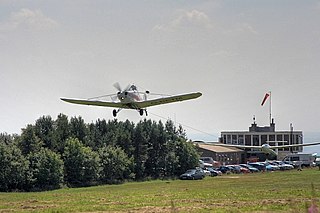
London Luton Airport is an international airport located in Luton, Bedfordshire, England, situated 1.7 miles (2.7 km) east of the town centre, and 29 miles (47 km) north of Central London. The airport is owned by London Luton Airport Ltd (LLAL), a company wholly owned by Luton Borough Council, and operated by London Luton Airport Operations Ltd (LLAOL).

Haddenham is a village and civil parish in west Buckinghamshire, England. It is about 5 miles (8 km) south-west of Aylesbury and 4 miles (6 km) north-east of Thame in neighbouring Oxfordshire. At the 2011 Census, the population of the civil parish was 4,502.

Barton Aerodrome is an airport in Barton-upon-Irwell, Greater Manchester, England, 5 nautical miles west of Manchester. Formerly known as City Airport and City Airport Manchester, It is known by the Civil Aviation Authority (CAA) as Manchester/Barton and rebranded as Manchester Barton Aerodrome on 3rd April 2023.

Barton-le-Clay is a large village and a civil parish in the Central Bedfordshire district of Bedfordshire, England, bordering Hertfordshire. The village has existed since at least 1066 and is mentioned in the Domesday Book.

Dart Aircraft Limited was a British aircraft manufacturer during the 1930s. Its facilities were located at 29 High Street North, Dunstable, Bedfordshire.

The Luton L.A.4 Minor was a 1930s British single-seat high-wing ultra-light aircraft. The prototype was built by the Luton Aircraft Limited, and design plans were later adapted and copies sold for homebuilding.

The Luton Buzzard was a 1930s British single-seat, open cockpit ultralight aircraft built by Luton Aircraft Limited.
Luton Aircraft Limited was a British aircraft manufacturer of Barton-in-the-Clay, Bedfordshire, and later Gerrards Cross, Buckinghamshire.
Cecil Hugh (Chookie) Latimer-Needham was a British aircraft designer, inventor and aviation author. He is best remembered for the series of aircraft he designed for the Luton Aircraft company and his invention of the Hovercraft skirt for which he was granted a patent. His book, Aircraft Design proved to be an invaluable reference work for Bill Goldfinch and Jack Best during their construction of the Colditz glider. The Germans were rather careless in providing a copy of the book in the Colditz prison library.

The Schweizer SGS 2-32 is an American two-seat, mid-wing, two or three-place glider built by Schweizer Aircraft of Elmira, New York.
Samlesbury Aerodrome is a disused airfield at Balderstone near Samlesbury and Blackburn in the Ribble Valley district of Lancashire. The aerodrome is owned by defence company BAE Systems which uses the site for the manufacture of several different aircraft. Currently the company employs approximately 3,000 people at the site. The aerodrome is part of Lancashire Enterprise Zone.
The Slingsby T.25 Gull 4 is a British glider designed and built by Slingsby that first flew in 1947.

The Hordern-Richmond Autoplane was a 1930s British twin engined two seat cabin touring monoplane designed by Edmund Hordern, and constructed by Heston Aircraft Company Ltd.

Penshurst Airfield was an airfield in operation between 1916–36 and 1940–46. Initially a military airfield, after the First World War it was used as an alternate destination to Croydon Airport, with some civil flying taking place. The airfield closed following the crash of a Flying Flea at an air display in 1936, and was converted to a polo ground.
Ramsgate Airport was a civil airfield at Ramsgate, Kent, United Kingdom which opened in July 1935. It was briefly taken over by the Royal Air Force in the Second World War, becoming RAF Ramsgate. The airfield was then closed and obstructed to prevent its use. It reopened in 1953 and served until final closure in 1968. The site has now been redeveloped as an industrial estate.
The Dunstable Sailplane Company was established in 1934 by W.L. Manuel and C.H. Latimer-Needham to design, manufacture and repair gliders from its workshop at Barton-Le-Clay Airfield in Bedfordshire.

The Hütter Hü 17, is a German high-wing, strut-braced, single-seat, utility training glider that was designed by brothers Ulrich Hütter and Wolfgang Hütter in the 1930s.

Bekesbourne Aerodrome was an airport located at the southeast edge of the village of Bekesbourne, southeast of Canterbury, Kent. It operated from 1916 until 1940, and had both military and civil roles.

The Yorkshire Gliding Club (YGC) operate from an airfield on Sutton Bank in the North York Moors National Park, England. The airfield site is 7 miles (11 km) east of Thirsk along the A170 road and just south of the National Park visitors centre at Sutton Bank. The club formed in 1934 from an amalgamation of gliding concerns from the West Riding of Yorkshire and has been in existence for over 80 years and has had many famous fliers such as Nicholas Goodhart, Amy Johnson and Fred Slingsby.